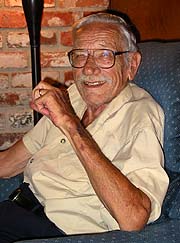Peter Berg’s tribute to Raymond F. Dasmann who died in Santa Cruz, California on November 5, 2002. Written in Bahia de Caraquez, Ecuador.
Besides his prodigious accomplishments in the fields of conservation and ecology, Ray Dasmann was an inspiring guide for learning how and what to observe.
During the gifted times when I walked in the woods with him, Ray didn’t utter more than a dozen words. He took so long responding to my questions on the first trip that I stopped asking, and he usually didn’t volunteer information. Simply being in a wild environment and looking was obviously sufficient. Sometimes he pointed. Once he gestured toward something and made a rare remark that was actually a question in itself, “Why do coyotes shit on stumps?” Considering the traditional metaphysical significance of coyotes for the indigenous people of California, the spread of this practice in the contemporary era of massive stump production may be a deeper comment than we suspect.
When he offered to take Aaron Rosenberg and me to an unusual place near the cabin where he lived on San Juan Ridge in the Sierra Nevada foothills, I assumed that it would be another unique experience. It turned out to be one of the rarest places I have been privileged to visit. Ray chose the site for his cabin because there was nothing behind it for hundreds of feet down the precipitous slope of the Yuba River gorge. We walked a short distance from the cabin and then followed the lip of the gorge. There was no trail through the tall Douglass Fir and Pine trees, but Ray picked his way with assurance. We could feel a cool breeze of updrafted air when we eventually passed over the rim and angled down a slight grade. Ray led us to the edge of a small naturally clear meadow and stopped. We watched silently as he stared straight ahead and began to take off his shoes.
He next removed his shirt and started to take off his pants. It was a baffling moment and I glanced at Aaron to see his response. He was taking off his shoes as well. Soon the three of us were standing completely naked while Ray looked over the ground straight ahead and to the sides. He took a few steps forward, crouched and stared at the skull of what was probably a raccoon. Parts of the backbone and legs were visible a few feet away. The beaked skull and wing of a large bird lay near them. A short distance more was part of the rib cage of a deer. Beyond that was a scattering of all kinds of wild animal remains. We walked a little farther and saw a small pelvis, antlers, single thigh bones, small piles of feathers, patches of fur. When we reached the center of the meadow there were bleached bones in every direction.
Ray walked off a little way without any regard for us. His eyes were radiant. I discovered that I was going completely inside myself and sat down. We had walked into a great secret. Out of sight and smell, this was a well-used hideaway for carrying caught prey and devouring it. The bones were picked clean but they were recent enough not to be covered with leaves. I didn’t reach for anything the way a more random discovery on a trail might be handled with curiosity. There were too many choices here to examine a single one closely. None of us seemed to want to disturb anything.
After a time my brain started up again. How many predators used this dining room? Who were they? What times were they active here? How many places like this existed? Had anyone else been here? And what were three naked human beings doing in a circle of wild bones? Silent speculations that weren’t going to get an answer then or maybe ever.
At a certain unspoken moment it was time to go. Taking our clothes off had been exactly the right thing. It was a direct way to respectfully take part in what we had been shown. We had gotten down to our basic species identity. Now it was right to get dressed and leave. We never spoke of the vision in the meadow again.
Ray and I spent plenty of other times discussing things intently over kitchen tables and during rides for a decade during the seventies and eighties. His generous influence in refining ideas about bioregions and having them accepted in ecological circles is part of a populist cultural and political history that lies outside all of his strictly professional accomplishments. Ray was even more than this. His greatest contribution to me was being how to see.

